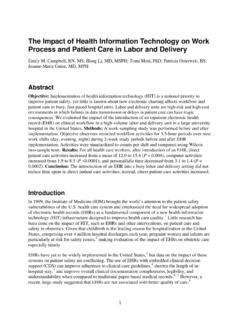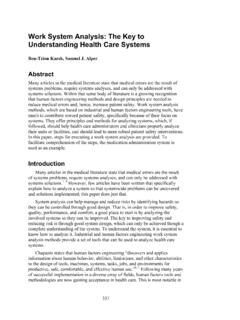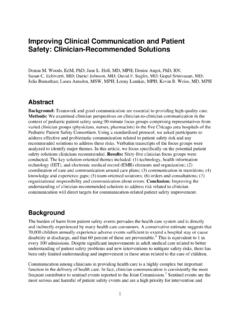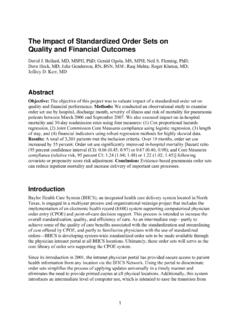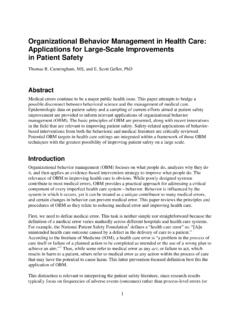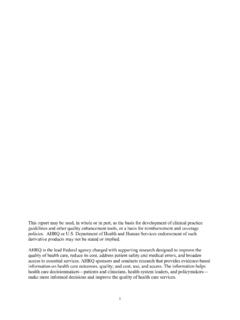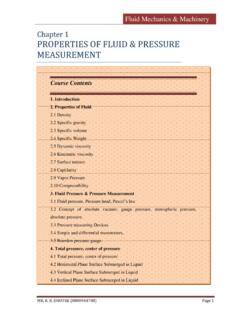Transcription of Wound Classification
1 Wound ClassificationPresented byDr. Karen Zulkowski, , RNMontana State UniversityWelcome!Thank you for joining this webinar about how to assess and measure a Little About Associate professor at Montana State University Executive editor of the Journal of the World Council of EnterstomalTherapists (JWCET) and WCET International Ostomy Guidelines (2014) Editorial board member of Ostomy Wound Managementand Advances in Skin and Wound Care Legal consultant Former NPUAP board member3 Today We Will Talk About How to assess a Wound How to measure a woundPlease make a note of your questions. Your Quality Improvement (QI) Specialists will follow up with you after this webinar to address them. 4 Assessing and Measuring Wounds You completed a skin assessment and found a Wound .
2 Now you need to determine what type of Wound you found. If it is a pressure ulcer, you need to determine the and Measuring WoundsThis is important because Each type of Wound has a different etiology. Treatment may be very Not all wounds are clear cut. The cause may be of Wounds Vascular (arterial, venous, and mixed) Neuropathic (diabetic) Moisture-associated dermatitis Skin tear pressure ulcer7 Mixed EtiologiesMany wounds have mixed etiologies. There may be both venous and arterial insufficiency. There may be diabetes and pressure Skin Damage Also called perineal dermatitis, diaper rash, incontinence-associated dermatitis (often confused with pressure ulcers) An inflammation of the skin in the perineal area, on and between the buttocks, into the skin folds, and down the inner thighs Scaling of the skin with papule and vesicle formation: These may open, with weeping of the skin, which exacerbates skin damage.
3 Skin damage is shallow or superficial and edges are irregular or diffuse. Maceration or a whitening of skin may also be observed. Results when epidermis is damaged and bacteria are then able to penetrate beneath the surface 9 Moisture-Associated Skin DamageDetermine what it it pressure or moisture? May be difficult to distinguish between moisture-associated skin damage and pressure ulcer. Unlike moisture-associated skin damage, a pressure ulcer usually has distinct Ulcers From Other Sources of pressure Boots, boot straps, oxygen/endotracheal tubes, stockings, and other devices can also lead to pressure -induced ischemia on the skin. These are counted separately for incidence and pressure Ulcer Definition.
4 Localized injuryto the skin and/or underlying tissue usually over a bony prominence, as a result of pressure , or pressure in combination with shear. 12 NPUAP/EPUAP pressure Ulcer Prevention and Treatment Guidelines. pressure Perpendicular force Compresses tissue Restricts blood flow Causes ischemia and necrosis Ruptures cells and vessels Causes tissue deformation13 Shear Force parallel to the skin Stretches and distorts internal tissue May cause occlusion of vessels perpendicular to skin surface Leads to ischemia and necrosis14 pressure Ulcer Staging Concepts NPUAP Classification system: 6 stages or categories: Stage I Stage II Stage III Stage IV Unstageable Suspected deep tissue injury (sDTI) Base staging on the type of tissue visualized or palpated.
5 Do not reverse stage when documenting a healing pressure is based on the type of tissue visualized or palpated16 QUICK GUIDE FOR pressure ULCER STAGING Partial thickness ulcer Stage I Intact skin with non-blanchable redness of a localized area usually over a bony prominence Stage II Loss of dermis presenting as a shallow open ulcer with a red-pink Wound bed or open/ruptured serum-filled blister. Full thickness ulcer Stage III Subcutaneous fat may be visible but bone, tendon, or muscle are not exposed. Stage IV Exposed bone, tendon or muscle. Suspected deep tissue injury Purple or maroon localized area of discolored intact skin or blood filled blister due to damage of underlying soft tissue from pressure and/or shear.
6 Unstageable Base of Wound is covered by dead tissue Zulkowski, 2012 Stage IDefinition Intact skin with nonblanchableredness of a localized area, usually over a bony prominence. Darkly pigmented skin may not have visible blanching; its color may differ from the surrounding Area may be more painful, firm, or soft, or warmer or cooler than adjacent tissue. Stage I may be difficult to detect in persons with dark skin tones. 17 Source: National pressure Ulcer Advisory PanelStage IIDefinition Partial thickness loss of dermis presenting as a shallow open ulcer with a red/pinkwound bed, without slough. Mayalso present as an intact or open/ruptured serum-filled or sero-sanguineous filled Presents as a shiny or dry shallow ulcer without slough or bruising.
7 This stage should not be used to describe skin tears, tape burns, incontinence-associated dermatitis, maceration, or :National pressure Ulcer Advisory Panel18 Stage IIID efinition Full thickness tissue loss. Subcutaneous fat may be visible but bone, tendon, or muscle are notexposed. Some slough may be present. May include underminingand The depthof a stage III pressure ulcer varies by anatomical location. The bridge of the nose, ear, occiput, and malleolus do not have adipose subcutaneous tissue and stage III ulcers can be shallow. In contrast, areas of significant adiposity can develop extremely deep stage III pressure ulcers. Bone/tendon is not visible or directly :National pressure Ulcer Advisory PanelStage IVDefinition Full thickness tissue loss with exposed bone, tendon, or muscle.
8 Sloughor escharmay be present. Often include underminingand The depthof a stage IV pressure ulcer varies by anatomical location. The bridge of the nose, ear, occiput, and malleolus do not have adipose subcutaneous tissue and stage IV ulcers can be shallow. Stage IV ulcers can extend into muscle and/or supporting structures ( , fascia, tendon, or joint capsule), making osteomyelitis or osteitis likely to occur. Exposed bone/tendonis visibleor directly palpable. 20 Source:National pressure Ulcer Advisory PanelboneUnstageableDefinition Full thickness tissue loss in which actual depth of the ulcer is completely obscured by slough (yellow, tan, gray, green, or brown) and/or eschar (tan, brown, or black) in the Wound Until enough slough and/or eschar is removed to expose the base of the Wound , the true depth cannot be determined but it will be either a Stage III or IV.
9 Stable (dry, adherent, intact without erythema or fluctuance) eschar on the heels serves as the body s natural (biological) cover and should not be : National pressure Ulcer Advisory PanelSuspected Deep Tissue InjuryDefinition Purple or maroon localized area of discolored intact skin or blood-filled blister due to damage of underlying soft tissue from pressure and/or The area may be preceded by tissue that is painful, firm, mushy, or boggy, or warmer or cooler than adjacent tissue. Deep tissue injury may be difficult to detect in individuals with dark skin tone. Evolution may include a thin blister over dark Wound bed. The Wound may further evolve and become covered by thin eschar. Evolution may be rapid, exposing additional layers of tissue even with : National pressure Ulcer Advisory PanelSuspected Deep Tissue Injury Difficult to say with certainty as outer skin may be intact.
10 Sometimes it really is a bruise. Damage is to deeper tissue and when you see purplish area it is too late to prevent. Better to document exactly what you see than have a facility-acquired of sDTI Falls Long OR/ER or transportation times Splints Accidents24 Medical Device-Related pressure Ulcers of all identified pressure ulcers of facility-acquired pressure ulcersMost frequent locations25 Anatomic LocationPercentage of Device-Related pressure UlcersEars20%Sacral/coccyx region17%Heel12%Buttocks10%Remember the Bariatric Patient Check between the skin folds and thighs: Rash Maceration Infection (bacteria or candidiasis) Breakdown pressure ulcers may be in unusual the Wound27 TTissue both in and around the Wound granulation, slough, necrotic black, pink, Any open area always has the potential for (exudate).

